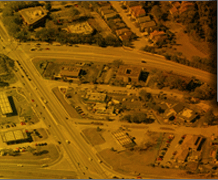|
|
|
|
technical memoranda |
www.devoeng.com |
- Practitioners
- Research
- Academia
- Geology
- Marion County Hydro
| |
PONDS Software – Technical Notes & Procedures
|
|
|
- How to compute nutrient removal in chained wet ponds.
The combination of two wet ponds in series is not directly addressed in the currently proposed methodology (Harper method) for calculating the nutrient removal of a wet pond. When analyzing two wet ponds in series (as depicted in Exhibit 1 below) we suggest that the two wet ponds should instead be considered as a single wet pond, and the residence time of the combined ponds should be calculated using the combined (permanent pool) volumes. |
- Modeling Contiguous Ponds With Shared Borders.
One way to model this is to assume that the shared perimeter becomes a no flow boundary, and that no horizontal flow can occur through that boundary. This reduces the length of perimeter which is available for saturated horizontal infiltration, so the “effective” (i.e., non-shared) perimeter should be used for modeling. An effective pond length and width are then chosen which will generate the same length of effective perimeter. |
|
|
|
- Retaining Walls Around Ponds.
How to modify the horizontal hydraulic conductivity value to model the effect of a partially penetrating or completely penetrating retaining wall/clay core around a retention pond. |
- Analyzing PONDS With Sand Chimneys.
In some areas (such as in the Florida Panhandle) when a hydraulically restrictive soil layer occurs near the pond bottom, it is common to excavate the restrictive soils beneath the pond bottom and backfill with a more permeable material in order to access the underlying permeable soil layer and improve pond recovery performance, as illustrated in Exhibit 1 below. This configuration is sometimes referred to as a “sand chimney”. |
|
- Calculating Effective Length and Width of a Pond.
In the PONDS 3.2 Refined Method, the effective length and width determine the length of the perimeter which is available for saturated horizontal infiltration. PONDS assumes that the pond rectangular in shape (and the effective length and width are used to set up the finite difference grid used in Modflow for PONDS). However, real-world pond geometry is often irregular, or non-rectangular, so the actual pond must be approximated by an equivalent rectangular pond. |
|
|
|
- Using PONDS for Dewatering Analysis.
In PONDS, a dewatered excavation (or borrow pit) is modeled as a pond whose discharge structure elevation is set to the controlled water elevation during dewatering. The groundwater is then allowed to infiltrate (through background seepage) into the pond and is discharged through a control structure. |
|
|
- Interfacing PONDS 3.2 with AdICPR v3.
PONDS 3.2 has the ability to interface with earlier versions of AdICPR (v1.4 and 2.x) by importing hydrographs directly from, or exporting hydrographs directly to, an ICPR *.hyd or *.bdq file... |
|
|
| |
PONDS Software – Installation & Operation Errors
|
|
- Compatibility with Windows 7.
Some users have reported difficulty printing to Adobe Acrobat in Windows 7, and this compatibility setting has been effective in overcoming the printing problem with Adobe. |
|
- Potential Issues in Windows Vistas.
In Windows Vistas, Microsoft has introduced a feature called User Account Control (UAC). In theory, this feature improves the security of your computer by overriding the Administrator user rights for local users and assigning regular user rights. One of the effects of this option is that Windows Vistas will frequently interrupt a process in order to ask you whether you want to proceed. Another consequence of the UAC is that it prevents users from saving files to the Program Files directory under some conditions. The PONDS software saves a number of data files in the C:\Program Files\Ponds32\ directory, including: temporary data files, recent files list, user options, etc. If the UAC is activated, it could prevent PONDS from operating as it should. |
- PONDS 3.2 Compatibility Issue with Norton Antivirus.
We have updated the installation set for PONDS 3.2 to resolve an incompatibility issue between PONDS 3.2 and Norton Antivirus (as well as Avast Antivirus). It appears that on Dec 16, 2008, Norton Antivirus introduced some changes in their software that resulted in it misidentifying the PONDS 3.2 executable files as being infected with a virus. This is a FALSE POSITIVE, as we have no reason to believe that the files are actually infected. The problem stems from the fact that PONDS 3.2 was using older hardware locking software that had not been updated recently, as well as the new changes to Norton Antivirus. |
- Device driver conflict with AdICPR version 3 for Windows.
Both PONDS and AdICPR v3 use hardware locks manufactured by Aladdin Knowldege Systems. Currently, the PONDS 3.2 Application Suite uses the Aladdin HASP hardware lock. However, previous versions of PONDS, including the standalone PONDS 3.2 Refined Method Module, have used the Aladding Hardlock LT hardware lock. Aladdin Knowledge Systems no longer supports the Harlock LT hardware lock. |
| |
Hydrology Notes and Publications
|
|
|
- Pervious Pavement Systems and Excel Design Aid.
Provides additional information, training and reference materials to Professional Engineers so they may successfully design storm water management systems that meet their client’s objectives, while protecting the interests of the public.. |
|
|
|
- How to estimate Hydrologic Soil Group Using 2007 Criteria.
This chapter contains the official definitions of the various hydrologic soil groups. The National Soil Survey Handbook (NSSH) references and refers users to NEH630.07 as the official hydrologic soil group (HSG) reference. Updating the hydrologic soil groups was originally planned and developed
based on this perspective. |
| |
General Engineering Notes
|
|
- Florida’s Sinkhole Database.
In this link you will find two different types of files. One is an Excel Spreadsheet and the other is an ESRI ArcGIS compatible shapefile. Both types of files have been provided as self extracting .exe and zipped files. Each file provides information on possible sinkholes as reported to the Florida Geological Survey and updated through September 4, 2009.
|
- Fill Berm Stability.
Although PONDS does not directly perform a stability analysis of a pond berm, it can be used to determine the seepage path through the berm in order to assess the likelihood of a seepage failure... |
|
| |
|
|
Methane Generation in Soil & Vapor Intrusion into Residential Structures:
- Indoor Air Vapor Intrusion Mitigation Approaches
The U.S. Environmental Protection Agency (EPA) Engineering Issue in one of a new series of technology transfer documents that sum- marize the latest available information on selected treatment and site remediation technologies and related issues.
- Proposed Regulatory Framework for Evaluating the Methane Hazard due to Vapor Intrusion
Methane is often found at percent levels in soil gas and it has become a chemical of concern at some vapor intrusion (VI) sites. The evaluation of methane, however, differs fundamentally from the evaluation of volatile organic compounds (VOCs) and the regulatory framework for addressing methane is either nonexistent or inadequate in most cases.
- Advisory On Methane Assessment And Common Remedies At School Sites.
This advisory provides guidance on investigations and common remedies for school sites where methane gas is the only chemical of concern present in subsurface soils. This advisory may be used to supplement remedies for sites with multiple contaminants in soil gas, e.g., hydrogen sulfide or volatile organic compounds (VOCs), in addition to methane...
- Method of estimating biogenic methane production at fill sites.
Methane is found in areas where buried organic materials decompose in the absence of oxygen. It is produced when methanogenic microbes convert organic materials into methane and carbon dioxide...
|
|
|
|
|
|
|
|
|
|
- Storm Water Technology Fact Sheet (Bioretention).
Bioretention is a best management practice (BMP) developed in the early 1990's by the Prince George's County, MD, Department of Environmental Resources (PGDER). Bioretention utilizes soils and both woody and herbaceous plants to remove pollutants from storm water runoff. |
|
- Storm Water Technology Fact Sheet (Bioretention).
Bioretention is a best management practice (BMP) developed in the early 1990's by the Prince George's County, MD, Department of Environmental Resources (PGDER). Bioretention utilizes soils and both woody and herbaceous plants to remove pollutants from storm water runoff. |
|
|
|
- Definitions of the Seasonal High Ground Water Table (SHGWT).
Formal definition of the Seasonal High Water Level (SHWL) from our District’s “Basis of Review” (BOR): Section 1.7.35 "Seasonal High Water Level" - The elevation to which the ground or surface water can be expected to rise due to a normal wet season. |
|
- Efficiency Criteria.
This memo briefly discusses some issues regarding the water quality treatment volume calculations proposed in the draft FDEP Stormwater Quality Applicant's Handbook, and issues raised during meetings of the Technical Advisory Committee (TAC). |
|
- Volume-Based Hydrology.
Examining the shift in focus from peak flows and pollution treatment to mimicking predevelopment volumes. |
|
|
|
- Florida Rain Gardens.
A rain garden is a man-made depression in the ground or a bio-retention area used as a landscaping tool to improve water quality. The rain garden collects runoff from your roof, driveway and lawn, temporarily stores it, and permits it to be filtered and slowly absorbed by the soil. |
|
- Seasonal Variability of Near Surface Soil Water and Groundwater Tables in Florida.
The water table and its range of fluctuation are required design factors for most projects that involve altering the landscape. In order to estimate the affect of a proposed alteration on surface water quality and quantity, it is necessary to determine the current or predevelopment water table conditions. Most regulations stipulate that no significant change can be imposed to these conditions. Typically, it is the maximum or high water level that is a required design criterion. Several terms have been adopted regarding the maximum high water level, with one of the most common terms being seasonal high groundwater table (SHGWT). |
|
- Dealing with iron and other micro-irrigation plugging problems.
The objective of this document is to describe problems with emitter plugging and discuss management strategies to overcome and correct causes of plugging in micro-irrigation systems. This publication focuses, in particular, on iron scaling, documenting recent successes in treating this common problem in Florida. or if smaller particles stick together to form a much larger mass, then emitter plugging is likely. Filters are the primary defense against particles
entering the micro-irrigation system. The most economical solution is to buy the best filtration. |
|
- Blue-green algae in Florida waters.
Blue-green algae, or “cyanobacteria,” are structurally similar to bacteria but, like plants, use sunlight to grow. Blue-green algae occur naturally in both freshwater and marine (salt) water bodies. Most live with other types of algae and microscopic animals in floating “plankton.” |
|
|
|
|
|
- PONDS 3.3 APPLICATION SUITE RELEASE.
The Florida Department of Environmental Protection (FDEP) is planning to adopt new state-wide stormwater treatment rules for the design of stormwater management systems. The new rules propose to adopt a requirement for no-net-increase in the pre vs postdevelopment nutrient loading in stormwater runoff from a site. |
|
- Florida Friendly Landscaping Guide.
The Florida Yards & Neighborhoods (FYN) program addresses the serious problems of pollution in stormwater runoff, water shortages and disappearing habitats by enlisting Floridians in the battle to save our natural resources. |
|
- Modeling Sinkholes in SWFWMD.
Sinkholes are a common occurrence in karst-sensitive areas throughout Southwest Florida. As development pressures continue, more comprehensive regulations need to be developed to protect the aquifer in karst-sensitive areas from untreated storm water. |
|
- Estimating the normal Seasonal High Groundwater Table.
This article briefly describes the methods employed and factors considered by scientists and engineers in estimating the depth below land surface to the seasonal high groundwater table. Although this article focuses more on the Orlando (Florida) area, the methodology described herein is general and can be applied to other areas. |
|
- Unit Hydrograph Shape Factor Memo from SJRWMD.
Sections 10.3 and 12.0 of the Management and Surface Waters (MSSW) applications handbook provides methodologies for calculating peak discharge in order to meet the peak discharge criteria in section 10.3 of the applicants handbook. The Handbook explains that peak discharge estimates should be make using a District approved hydrograph method... |
|
|
|
- Evaluation of Current Stormwater Design Criteria within the State of Florida.
This report, prepared by Environmental Research and Design, Inc. (July 2007) evaluates the current design criteria of each of the WMDs and DEP to determine whether the minimum treatment level specified in 62-40, F.A.C. is being met. It provides updated information on rainfall patterns, land use specific event mean concentrations, and BMP effectiveness. It provides recommendations on a new performance standard of post-development nutrient loading shall not exceed pre-development nutrient loading and BMP design criteria that can
achieve this level of treatment. |
|
| |
|
|
- Inverse Condemnation in Flooding Cases
In the Old Testament Book of Genesis, God gets the credit or blame for a flood that covers the earth. (Genesis 6 - 7). In order to save Noah and his descendants, God orders Noah to build an ark of “gopher wood.”... |
|
|
|
|
|
|
|
| |
|
|
|
|
|
|
|
|
|
|
- Hydrogeological Units of Florida, Florida Geological Survey Special Publication 28 (revised 2009).
In 1986, the Florida Geological Survey (FGS) published the first guidelines for naming Florida’s aquifers and confining systems (Southeastern Geological Society Ad Hoc Committee, 1986). These guidelines have served Florida well for 20 years but they concentrated on the most productive aquifers. Florida’s explosive growth has resulted in a need for developing expanded water sources, including less productive aquifers that were not emphasized in the 1986 guidelines. This report presents an updated set of guidelines for naming aquifers which changes the focus to all strata that are capable of producing water to a well and that have potential for public or private supply. |
|
|
|
|
|
|
|
|
|
|
|
|
|
- Ancient Sea Level Stands in Florida
This report was prepared in cooperation with the University of Florida and is the first of several that will result from a study of the heavy minerals in Florida.
Florida Geological Survey, Bulletin No. 52
|
|
|
|
- Springs of Florida, Florida Geological Survey Bulletin 66 (2004)
There are two general types of springs in Florida, seeps (water-table springs) and karst springs (artesian springs). Rainwater, percolating downward through permeable sediments, may encounter a much less permeable or impermeable formation, forcing the water to move laterally... |
|
|
|
|
|
 |










